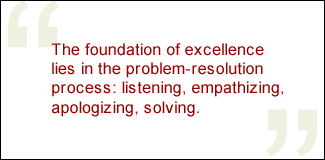The key to success in the hospitality industry lies in enhancing the guest experience and providing excellent customer service. This phrase -- or a variation on it -- has been repeated so often that most industry leaders can recite it, verbatim, in their sleep. And this notion is so prevalent -- and so powerful -- because it's absolutely true.
Too often, though, hotels and restaurants fail to capitalize on a perfect opportunity to enhance the guest experience. It's probably because that opportunity is initially disguised as a problem -- and I use that word deliberately. Hotels and restaurants have an unexpected opportunity to engage a guest when he or she has a problem -- if it is handled with excellence.
 |
What's the problem here?
Hospitality customers who are most likely to be fully engaged are guests who are delighted by their experience and who feel that the property met or exceeded its brand promise. Guests with problems that aren't resolved to their satisfaction are three times less likely to be fully engaged with the property or brand, according to 优蜜传媒research. When guests are extremely satisfied with the problem resolution offered by the property, however, they are about twice as likely to be fully engaged as guests who are less than extremely satisfied. (See graphic "How Engaged Are Your Customers?" in this article and "The Constant Customer" in the "See Also" area on this page.)
According to research reported by the online publication 4Managers, on average, each unhappy customer tells 11 people about his or her bad experience; 13% tell up to 20 people about their unhappy experience. And, for every disappointed customer who complains about a problem when it occurs, another 19 will leave the property without making a complaint.
 |
To hoteliers, the issues themselves may seem totally ordinary: the wrong room type, a lost reservation, noise disturbance, no breakfast table available. To guests, however, problems like these are meaningful enough to ruin a stay, but the majority of guests -- 19 out of 20 -- may never say a word; they'll just suffer in silence and resolve to avoid that property. This means that for each customer who speaks up about a problem, it's likely that 20 are spreading the word about their dissatisfaction far beyond management's sphere of control. So beware; a low number of customer complaints may not mean a low number of problems.
Thankfully, some guests do complain, which gives management the chance to rectify the problem and create a deeply engaged customer. The key is to deal with the guest's problem the right way. The difficulty, however, is that there is no one right way.
Everyone knows how problem resolution works: Take the guest to the side, listen carefully, don't interrupt, be empathetic and sympathetic, apologize, then offer a solution. But do we actually do it? Are we putting ourselves in the guest's position? Do we try to understand exactly what bothers guests? Do we truly care? Most importantly, do we offer the appropriate solution? Examples from the industry suggest that we do not.
Thanks, but no thanks
At a recent hospitality industry conference, an executive of one of the largest hotel chains in the world gave an example of an experience he once had at a hotel. He was traveling on business, and all he wanted was some rest in his room before his next appointment. To his dismay, his room was right next to a construction site. This would be a minor issue for some guests, but to him it wasn't; under the circumstances, sleep was impossible. So he complained at the front desk -- and they brought him a fruit basket.
Here's another example, and it happened to me. A restaurant served me a meal that was totally inedible. Even the garnish looked ill. When the waiter eventually came by, I told him my problem -- and he offered me a free cup of coffee. I explained that I didn't want coffee, I wanted dinner. The waiter, who gave me the impression that he was taking a huge professional risk, upped the ante and offered me a free dessert.
Both examples show a complete lack of interest in the guest's problems. The hotel exec should have been offered another room. He needed sleep, and a fruit basket wasn't going to solve his problem. If the hotel didn't have a quiet room available, it should have dispatched room service with ear plugs and a soothing cup of hot tea. Better yet, it should have offered to book him in another hotel. That's not as risky as it sounds: Guests will feel that the hotel genuinely cares if it's willing to forgo revenue from that room, and very few customers will opt to move -- the hassle is too great.
Similarly, the restaurant that served me inedible food should have offered me another meal or comped the one they had served me (in case I was too disgusted to eat something else). Furthermore, the waiter should have known which menu items were the fastest to prepare, because I was in no mood to wait around for their second try. A free cup of coffee or dessert wasn't going to solve my problem. Hungry people just want dinner.
Resolution
In his book Married to the Brand, William J. McEwen writes: "Only about one in seven customer problems are typically handled at excellence, our research reveals. What's more, anything less than excellence appears to be enormously destructive, placing the brand marriage in peril." Because the hospitality industry relies so much on human effort, human error is inevitable, but imperiling customer engagement is not. It is quite possible to put problem-resolution processes in place, and most properties do. But those processes aren't effective unless they are handled with excellence.
 |
The foundation of excellence lies in the standard problem-resolution process: listening, empathizing, apologizing, solving. That's also where, most of the time, the process fails. Staff members may be told the process, but many times they don't do it, or they don't do it the right way. The right way to resolve a problem is to tailor the response to what the individual needs; an appeasement offered merely to reduce hostility is not a solution. Real solutions require a certain amount of creativity, which means that customer-facing employees need latitude to make appropriate responses. Immediacy counts. So does attention to detail. But the standard fruit basket should be strictly prohibited, unless the guest's complaint is vitamin deficiency.
Premium customers
It's strange but true: Satisfied customers are no more likely to be loyal to a brand than dissatisfied ones, according to 优蜜传媒research -- but satisfied customers won't tell 11 people about the rotten experience they had in a restaurant. More importantly, fully engaged customers represent a 23% premium to a business, according to 优蜜传媒research, while actively disengaged customers represent a 13% discount. That ought to be reason enough to make problem resolution a serious undertaking in the hospitality industry.
So remember: Whenever a guest has a problem, it's an opportunity to build engagement. That complaining guest might provide you with a clue to a hidden weakness that, if fixed, could prevent 19 other guests from leaving angry (but without reporting a complaint). So perhaps the new catchphrase should be: The key to success in the hospitality industry lies in enhancing the guest experience, providing excellent customer service -- and creating engaged guests by solving problems at excellence.
